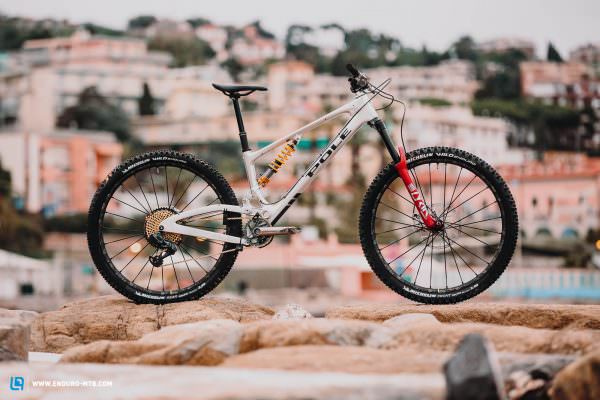One thing is certain: enduro bikes are booming and the choice and variety of bikes has never been better. We gathered the current most exciting models for this group test and put them through their paces. What is the best enduro bike of 2020 and what should you look for in a bike?

This article was originally published in February 2019 and updated in late 2019, where we added 12 more bikes to this year’s group test. To ensure consistency, we re-tested both the Best in Test and the Best Value Tip. Our group test reveals which is the best enduro bike currently available and which secures our Best Value Tip. Let us tell you now: there were quite a few exciting innovations and results.
What are enduro bikes?
The mountain bike market is constantly changing and bikes have evolved in leaps and bounds over the years. Trail bikes are becoming increasingly capable and enduro bikes have become even more efficient. Traditional parameters such as travel or wheel size are no longer the only indicators of a bike’s intended application. Nevertheless, the difference between trail and enduro bikes is relatively easy to explain: trail bikes are all-rounders that excel at riding up and down every kind of trail, as our high-end trail bike group test proves. Enduro bikes are even more capable on the descents. They take big hits in their stride and let you conquer the roughest terrain with ease. Even full-on downhill tracks don’t faze them. Compared to trail bikes, they’re significantly faster through demanding terrain. Conversely, on flowing, flat trails, enduro bikes often feel like a bit too much bike and tend to feel indirect or sedate. Climbs are no problem on enduro bikes, but they’re only a means to an end.


The test field in this enduro group test
The 2019 season saw loads of exciting new and even more capable enduro bikes introduced. In addition to the Specialized S-Works Enduro, Santa Cruz Megatower, Rocky Mountain Slayer and Pole Stamina 180, the Nukeproof Mega 290 Carbon caused a lot of excitement even before we reviewed it in our group test. Orbea have worked on the suspension of the Rallon, increasing the travel and making it more progressive, all with the help of a new rocker link. We had the brand new Norco Sight C1 on test, which Norco actually position between their trail and enduro bike offerings. However, with its promising geometry and 160 mm travel up front, it fit into this enduro group test perfectly. The Nukeproof Mega 275 and the Ibis Mojo HD5 were the only two 27.5″ bikes in the test field, while the others all roll on 29″ wheels. We also had the exclusive opportunity to review the as yet unreleased RAAW Madonna V2. The fledgling brand has already caused quite a stir with the first version of its bike, and now it’s been revised even further.
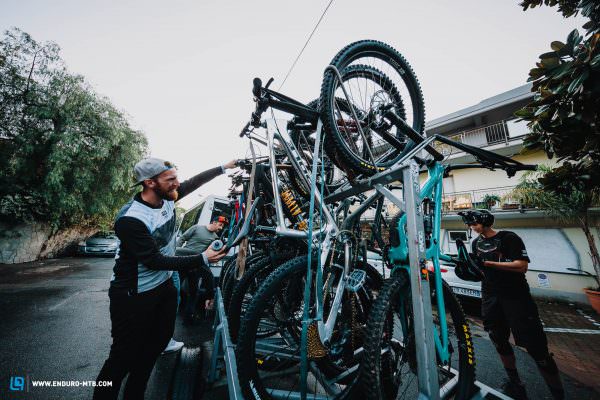





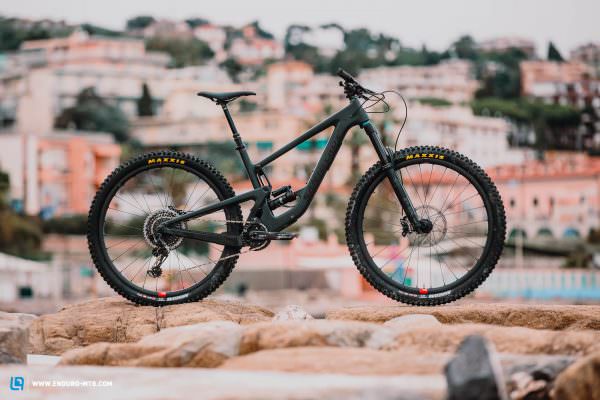

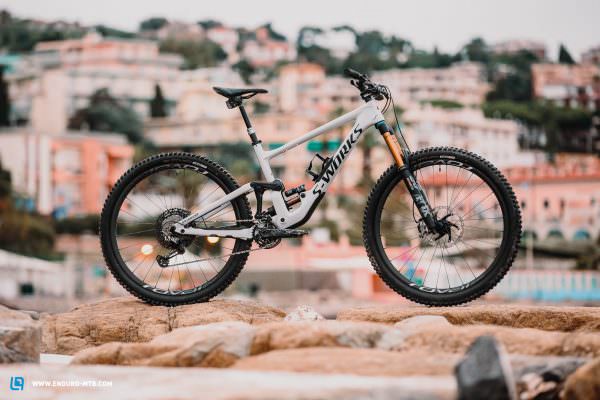



Why aren’t the Pivot Firebird, COMMENCAL META, Lapierre Spicy and others not included in the group field?
When we choose which bikes to include in a group test we orientate ourselves by what our readers want and our reader survey is the most important tool we have in finding out exactly what that is. We invited more brands than ever to take part in this year’s group test, focusing on the newest and most relevant models. The Bold Unplugged, COMMENCAL META, Lapierre Spicy, Pivot Firebird and the Santa Cruz Nomad were all included in our previous group test where we put them through their paces on the same trails in San Remo. To read the reviews of these bikes, simply click on the respective link.
| Bike | Price | Weight | Travel (f/r) | Wheelsize |
|---|---|---|---|---|
| Bold Unplugged (Click for review) |
€ 7,939 | 14.46 kg | 170/165 mm | 29″ |
| Commencal META AM 29 SIGNATURE ORANGE (Click for review) |
€ 4,399 | 15.48 kg | 170/160 mm | 27.5″ |
| Lapierre Spicy Team Ultimate (Click for review) |
€ 5,999 | 14.56 kg | 160/160 mm | 29″ |
| Pivot Firebird 29 Team XX1 (Click for review) |
€ 10,8999 | 13.66 kg | 170/162 mm | 27.5″ |
| Pole Machine EN (Click for review) |
€ 7,300 | 14.84 kg | 180/160 mm | 29″ |
| Santa Cruz Nomad CC (Click for review) |
€ 8,699 | 13.64 kg | 170/170 mm | 27.5″ |




Why did we include an eMTB in this group test?
If you’re wondering why there’s an eMTB in this group test, we had good reasons to include it: 18,930 ENDURO readers participated in our 2019 reader survey, giving us valuable feedback. Almost 47% said that they’re interested in eMTBs, 40% don’t mind reading about eMTBs and only 13% consider them a no-go. Interestingly, 45% of our readers have ridden an eMTB and over 3% see eMTBing as their main discipline.
Even in our personal riding groups and at grassroots events, one of the most common questions we get asked is, “Should my next bike be an eMTB?” Given the recent developments in the Enduro World Series in the form of the “EWS-E” have wised people to the fact that eMTBs can be a lot of fun. We’ve also seen how many (ex-)professionals have gotten on board. Riders like Fabien Barel, Jerome Clementz, Josh Bryceland, Curtis Keene, Matt Hunter, Hannah Barnes, Nico Vouilloz, Nico Lau, Gustav Wildhaber, Josh Carlson… It was clear that we at ENDURO would also have to deal with the subject sooner or later. Fortunately, we had the support of the terrific expertise of our sister magazine, E-MOUNTAINBIKE, which is considered the leading magazine in this segment.

So we decided to include the Specialized Turbo Kenevo, an eMTB with progressive geometry, a dual crown fork and the capabilities of a downhill bike, as our sister magazine E-MOUNTAINBIKE has already established. It’s obvious that an eMTB will beat every non-motorised bike on the climbs. However, we wanted to find how different the handling of the 24.2 kg bike would be in direct comparison to the top enduro bikes currently available.
Where did we test the bikes?
As usual for our group tests, we didn’t only ride the bikes extensively on our varied home trails but also put them head to head on the roughest and most demanding test track we could find. In this case, we traveled to Sanremo, as we did for our last high-end enduro bike group test, where we were assisted by Italian enduro veteran Manuel Ducci. The Due Muri Trail once again served up the perfect test track. After a quick start with open corners, rock-slabs, terraces and a few compressions, the demanding lower part of the trail offers steep slopes, drops, rock gardens and tight hairpin bends. In between, there’s a short climb on which the bikes had to prove their sprinting qualities. The premise: the best bike doesn’t just perform well on one section of trail, but excels in them all.
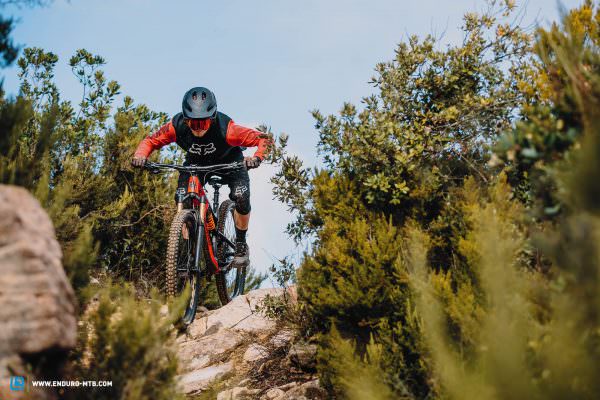

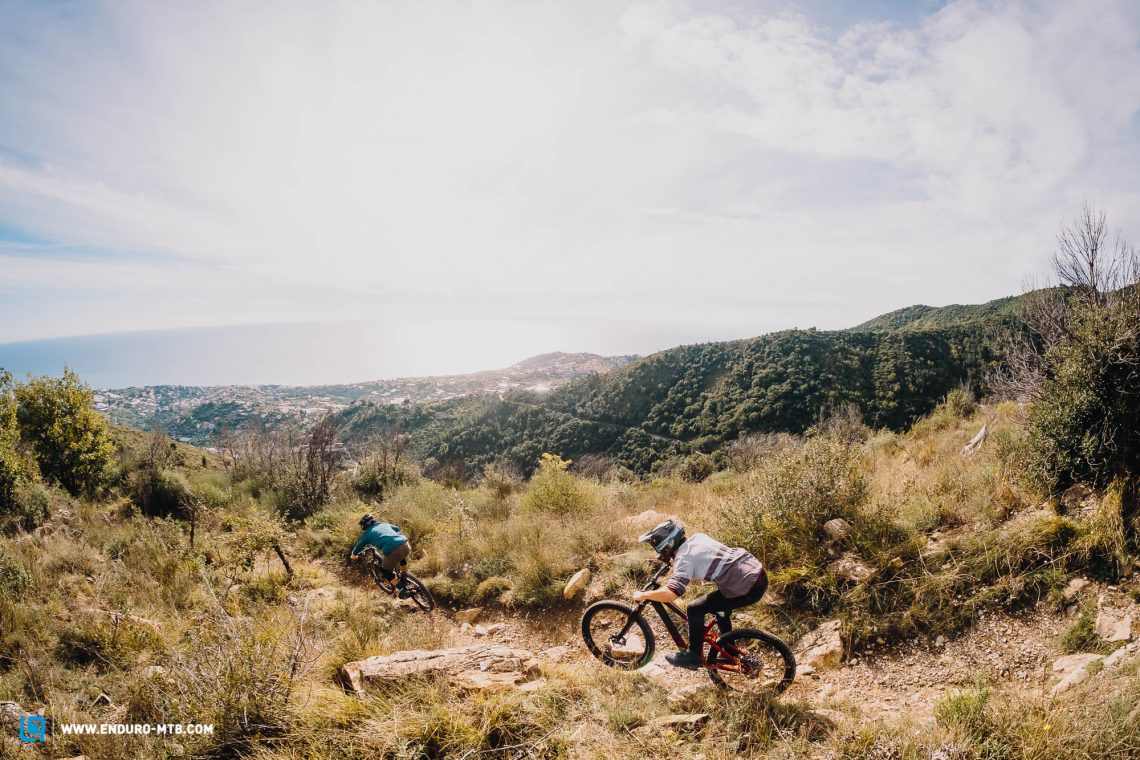
The riders
As always at ENDURO, the bikes were ridden by a team of test riders with different riding styles and requirements. For this group test, five riders traveled to Sanremo, while we also had a bunch of eager testers put the bikes to test on the trails around our Alpine office.

For me, the balance of a bike is crucial. Without weight on the front wheel, the rider ends up having to work hard to generate enough traction. The best bike sets itself apart from the rest with balanced, intuitive handling, making it easy to ride without excessive physical effort.

Agility is just as important to Lefti as speed and he loves catching air. In the past, the charming Austrian spent a lot of time in the dirt jump scene and for him a bike has to be able to take a hammering and obviously, jump well.

Biking is his biggest passion. Unless Michael is currently memorising the weights of wheels so he can recount the figures off by heart or conquering KOMs on his road bike, you will find him riding his mountain bike. For him, a good enduro bike has to climb really well and deliver a convincing performance on every descent.
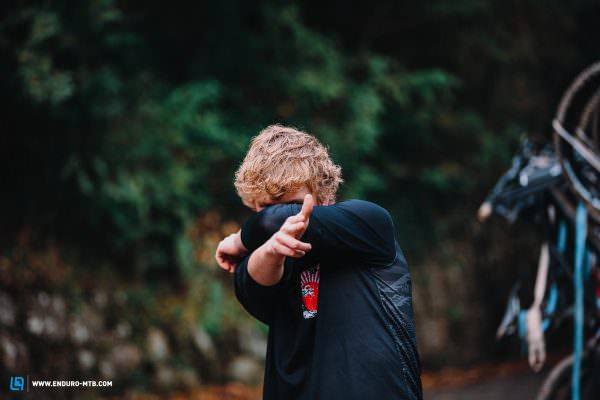
Let’s get loose! Finlay’s riding style is best described as fast and wild. Finlay loves to race, and he also loves to see if he can rip the tire off his rims in the corners. For him, agile, fun handling is important but not at the cost of high-speed stability.

As a newcomer to ENDURO, Stefan was curious to see if there was any noticeable difference between the bikes. All the more surprising for him was how much the individual bikes differed from each other and how unanimous the opinions of our test team were at the end.






Exciting facts and figures
Although the figures alone don’t tell the whole truth, they can still give us some exciting insights about developments and trends. Of course, we didn’t take the Specialized Turbo Kenevo into account when determining the averages or making comparisons with last year’s test.


The average price of the bikes in the test field is € 7,373, which is almost the same as last year. The most expensive bike is the Specialized Enduro S-Works at € 10,999. This is more than two and a half times as expensive as the most affordable bike on test, the CUBE Stereo which costs € 3,999.
On the subject of weight, there is an upward trend. On average, the total weight increased by 300 g, from 14.14 to 14.45 kg. The lightest bike in the test field is the SCOTT Ransom 700 Tuned weighing in at 13.42 kg and the heaviest is the Pole Stamina 180 at 15.72 kg. However, the wheels of the Pole alone are 740 g heavier due to the use of sturdier tires and tire inserts, which, incidentally, Pole are the only brand to fit as standard. In general, the weight differences had less of a negative impact on the climbs than many riders might still suspect.

Bei der Geometrie gab es mehrere spannende Entwicklungen. So wurde der Lenkwinkel um rund 0,4° flacher There were several interesting developments in geometry. Thus, head angles have became about 0.4° slacker and seat tube angles 0.9° steeper. Reach hasn’t changed by much in this year’s test field. Amongst other things, this is due to the fact that we didn’t have any bikes with reach measuring more than 500 mm as we did last year. Based on previous experience, we also tended towards sizing down when between sizes this year. However, based on the bikes that have been re-launched in the last 12 months, reach is only 4 mm longer on average, measuring 472 mm in size L. At the same time, the average wheelbase has become 29 mm longer, which can be attributed to both slacker head angles and longer chainstays. The average chainstay length of new 2019 bikes grew from 435 mm to 441 mm compared to the rest in size L (except for the Pole Stamina which we had in size medium).



We also made some interesting observations with regards to componentry, like FOX dominating the list of fork brands with a significant lead of 12 to 5 over RockShox. There were no other brands in the running. There is a similar trend in shocks with only the Pole Stamina 180 featuring an Öhlins coil shock. Shimano is celebrating a comeback in drivetrains and the Japanese brand can now be found on 7 of the bikes in the test field. You’ll find a SRAM Eagle drivetrain on the remaining 10. The battle between blue and red continues for the brakes with Shimano and SRAM tied at 8 to 8. Again, Pole is an exception to the rule, with the Finns choosing to rely on the powerful and outrageously expensive Trickstuff MAXIMA.



The 7 most exciting insights of the enduro group test
Since we don’t only review each bike individually but also compare them head to head on a defined test loop, we were able to gain some very interesting insights. It becomes more evident every time that familiar criteria such as weight, travel or geometry can only provide limited information about how a bike rides. Ultimately how a bike performs is determined by the sum of all parts, where besides countless other factors, the kinematics of the bike also play a crucial role.
1. Weight is not important
We often hear people say that they would have expected a lighter bike for the price. On average, the bikes in our group test weigh 14.45 kg. Super light bikes usually come at the expense of puncture resistant tires, lightweight wheels or undersized bearings on the rear linkage, which will require maintenance more often. The advantages of low weight are especially noticeable when you’re accelerating and on very long rides with hike-a-bike sections. On relaxed climbs, a balanced pedalling position and efficient suspension are far more important than a few grams on the scale.
At the same time, slightly more weight in the form of grippy tires, powerful brakes or good suspension will increase the amount of fun you have on the descents as well as the reliability of the bike. What is the point of saving of 500 g if you’re constantly having to fix punctures? For more exciting insights here, check out our big tire group test.

2. Climbing performance is characterised by the seat tube angle and the suspension
Let’s face it, there’s only one reason to ride an enduro bike uphill: to get to the top of an amazing descent. The time it takes to get there plays a secondary role. The most important thing is that you’re able to get there comfortably. To do so, it is essential you have a balanced pedalling position, which you get with a steep seat tube angle. However, on almost every bike in the test field, the saddles still have to be pushed forward. Besides that, it’s important that the rear suspension doesn’t wallow in its travel or bob up and down when you’re pedalling uphill. We found that the slightly heavier bikes on test with a steep seat tube angle climbed much more pleasantly than lighter models where you have to actively prevent the front wheel from lifting. Particularly noteworthy here are the Nukeproof Mega 275 and 290, the Orbea Rallon, the Norco Sight, the RAAW Madonna V2 and the Yeti SB150. The Pole Stamina 180 also climbs very well but the pedalling position on the size M felt too compact. This shows how a super steep seat tube angle compromises a bike if you don’t want an ultra-long reach on the descents.
3. The suspension is crucial
This group test included a bike with 150 mm travel that offers more reserves on the descents than other models offering 170 mm with similar geometry. It’s not all about the length of the travel but how efficiently the suspension uses of it. The magic words are leverage ratio, anti-squat, anti-rise and axle path. If you want to delve deeper into this topic, we’ve written a separate, much more in-depth article for you. The best suspension provides plenty of traction and keeps the bike safely on course but without absorbing too much energy and making the bike feel sluggish. However, it’s hard to tell how well the suspension performs just by looking at the figures or geometry, which is where our reviews can help guide your decision.

4. Form follows function – long dropper posts and bottle cage mounts are mandatory
It may sound trivial but things like bottle cage mounts in the front triangle or long dropper posts to get the seat completely out of the way still seem to be a challenge many brands haven’t been able to solve. Everything else has become so good that these should also become standard on the spec sheet. Bikes like the Nukeproof Mega or the YT CAPRA can offer the best handling in the world but if you have to carry a backpack or a hip-bag on every ride, these bikes will be out of the question for many buyers.
Thanks to ever longer dropper posts, seat tubes can be made shorter, which is just what a lot of brands are doing. Most of the newly introduced bikes have 400-450 mm seat tubes (in size L), which enables even the shortest riders to fit a long dropper post. Poor examples in the test field include the CUBE Stereo, the SCOTT Ransom and the Trek Slash, which all have 470 mm seat tubes and don’t offer the possibility of choosing the frame size according to your prefered reach. Read our dropper post group test to find out which dropper posts will give you the most travel on bikes with limited insertion depths.
5. 27.5″ is dead! At least for tall riders.
As recently as last year, the Nukeproof Mega 275 Carbon earned our Best Value Tip. But now Nukeproof have unveiled the new Mega 290 Carbon and it makes the 275 look old in comparison. Like most bikes in group test, the Mega 290C takes full advantage of the larger wheels: more grip and traction, better rollover and more stability at high speed. We found none of the alleged disadvantages that have long blemished the image of 29ers. Even during back-to-back testing we found they performed just as well in tight sections, when accelerating out of corners and throwing shapes in the air. Only short riders might encounter problems with the big wheels. The large rear wheel can occasionally get in the way on steep descents. Anyone who’s been following the pro racing scene knows that many teams have been very successful on mixed wheel sizes, running a 29″ up front and 27.5″ on the rear. It’s a pity that no brand has yet dared to send us a mixed setup for the group test. It would certainly be a good compromise for shorter riders.

6. Electrified mountain bikes are a ton of fun!
Some of our test riders had guessed as much, but others were quite surprised at how much fun the Specialized Turbo Kenevo was on our test track. Don’t worry, this isn’t going to be a promotional event for eMTBs. However, the fact is, the Kenevo has by far the plushest suspension on test, simply sticking to the ground. The 24.2 kg weight is significantly less noticeable than you would think too. Fast direction changes and tight sections are achievable on the Kenevo but you have to brake earlier and actively adapt your riding style. However, we still can’t tell you whether or not your next bike should be an eMTB. Apart from the performance of the bike, there are countless other aspects to factor into the equation. While some ride to have fun on as many trails as possible, others use mountain biking for a more balanced lifestyle, as a way to switch off from the day to day hustle. There’s almost something meditative about pedalling through the forest on your own, listening to your breath and focusing fully on your surroundings, which is something we’ve experienced a lot less on eMTBs. The social aspect of riding is just as important and it matters whether your riding buddies are on an eMTB or not. The only thing we can recommend is to try it out for yourself. Riding an eMTB and conquering that previously impossible crux on a climb feels terrific. Another awesome thing about eMTBs is that they help you overcome poor excuses for not riding, getting you out there despite the bad weather, a long working day or too little time. In any event, our test team agreed that good eMTBs like the Kenevo can be an excellent addition and in some cases even a great alternative to non-motorised bikes.

7. The best bikes have long chainstays
For 2020, the key word in excellent handling is balance! By the end of our group test, four 29ers emerged as the favourites of the entire crew and they all have one thing in common: relatively long chainstays, just over 440 mm in size L. Over the years, brands have tried to make the chainstays as short as possible, always on the grounds that they’re essential for agile handling. Now, as head angles have become slacker and the reach tends to be longer, overly short chainstays are counterproductive. If the chainstays are too short, they can unbalance the weight distribution and you have to work very hard to generate sufficient grip on the front wheel. We were particularly impressed with the extremely balanced handling of the Nukeproof Mega and the RAAW Madonna V2.

The best enduro bike of 2020
These days, the enduro segment can be roughly divided into two categories of bikes. On the one hand, there are those that are more reminiscent of a trail bike, with very direct handling that is just as much fun on flat trails but less capable of dealing with rough terrain. On the other side of the spectrum you’ve got more capable bikes that can easily handle demanding downhill tracks, with no trail too steep or too rough. Last year, these types of bikes had the disadvantage that they were no fun on easy trails but for 2020, the best have become much more versatile. Instead of covering all 17 bikes here, you will find a brief comparison with the most relevant competitors at the end of each review.
The Canyon Strive won our last high-end enduro bike group test and when we rode it again this year, we immediately remembered why it deserved to win the test. It offers the best of both worlds with handling that is agile yet incredibly capable on full-speed descents. However, for 2020 there are enduro bikes that are even more capable in rough terrain, offering a new level of speed without compromising on agility.



Tops

Santa Cruz, Specialized, Nukeproof and Rocky Mountain have managed to make their bikes super quiet. Very nice!

Ibis, Norco, Nukeproof, Orbea, Pole, SCOTT, Specialized, Trek and Yeti all fit at least a 170 mm dropper post on their size L bikes, giving you lots of freedom of movement on the descents.

Yeti, Norco and Specialized have online setup guides that make finding the base setting of the fork and rear suspension as stress free as possible – nice!

It’s the details like the tool stowed in the steerer tube that prove how much thought has gone into this bike.

Thanks to the revised rocker arm, Orbea have given the new Rallon more travel and improved the kinematics. The 160 mm travel suspension now responds much more sensitively than the 150 mm suspension of the previous model. You can buy the rocker arm separately for € 249 as an upgrade for the previous model.

Besides their size, the bearings on the RAAW Madonna V2 are sealed from the elements. We rode the V1 in Scotland for a whole year without being able to detect any signs of wear – brilliant! Bikes from other brands would have gone through three sets of bearings in that time.
Flops

The Shimano XT brakes perform brilliantly and they’re very reliable. However, they made an annoying rattling noise on several of the bikes in the test field and the bite point was inconsistent.

The E13 tires have a very square profile and used to buckle quite easily in hard-packed berms. They’ve been updated and the new version is a lot better – but it wasn’t mounted on this bike.

The design of the frame doesn’t accommodate any water bottles so you’ll always have to bring along a backpack or hip bag.

The rear linkage of the Enduro performs brilliantly. Unfortunately, it’s a chore to clean.

Unfortunately, the FOX 36 fork on the Canyon and SCOTT only has the FIT4 damper in it. The GRIP2 model performs better and gives you more tuning options to adjust the fork to suit your preferences – too bad.

The cockpit of the Slayer couldn’t convince any of our test riders. They all agreed that the stem is too short and the bars too wide. We recommend an upgrade here.
In the course of our test, four bikes emerged as clear favourites: the Nukeproof Mega 290, the RAAW Madonna V2, the Rocky Mountain Slayer and the Specialized S-Works Enduro. The Nukeproof Mega 290 Pro impressed us with its well-balanced handling and excellent suspension, but it feels a little less lively compared to the other three bikes and doesn’t have a bottle cage mount in the front triangle either – a no-go for day to day riding. The Rocky Mountain Slayer has by far the plushest rear suspension on test. It provides incredible traction and easily absorbs bumps of any size. However, the FOX DHX2 tends to sink into its travel in corners, which, in combination with the 40mm stem and very slack head angle, can make the front wheel difficult to control.

That leaves two bikes fighting for the podium: the RAAW Madonna V2 is the underdog here, with the fledgling bike brand founded by Ruben Torenbeek only two and a half years ago. Its aluminium frame is designed to offer performance and durability and RAAW prove that you don’t need a carbon frame for outstanding handling. The Madonna V2 is balanced, fun and above all else, damn fast! Thanks to the steep seat tube angle, it climbs very well despite being slightly heftier than the competition. This combination of uphill and downhill performance secures the RAAW Madonna V2 our coveted Best Value Tip!
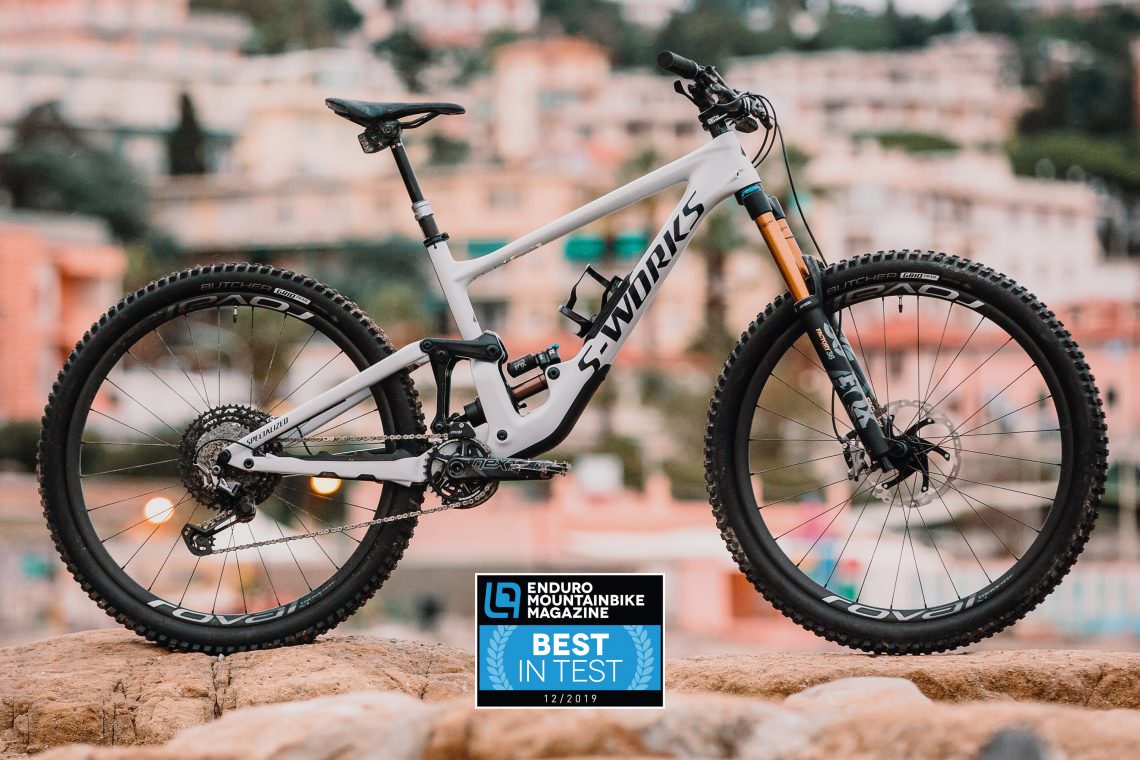
The only bike capable of topping the RAAW Madonna V2 is the Specialized S-Works Enduro. It’s rear suspension puts it in a league of its own. No matter how big the rocks, roots or holes, the Enduro swallows everything in its path. The most impressive part is that the bike remains composed doing so and continues carrying its speed. Yet despite this, it doesn’t feel sluggish and responds quickly to rider input. Despite its downhill performance, the Enduro climbs confidently too. To round it off, the bike is extremely well specced with high-quality components as well as many of Specialized’s ingenious features. It doesn’t get any better and the Specialized S-Works Enduro is crowned the best enduro bike of the 2020 season and our well-deserved Best in Test!
All bikes in test: Canyon Strive CFR 9.0 LTD | CUBE Stereo 170 SL 29 | Giant Reign Advanced 29 0 | Ibis Mojo HD5 | Norco Sight C1 29 | Nukeproof Mega 275C RS | Nukeproof Mega 290C Pro | Orbea Rallon M-LTD | Pole Stamina 180 LE | RAAW Madonna V2 FOX Factory Built | Rocky Mountain Slayer Carbon 90 29 | Santa Cruz Megatower CC X01 Reserve | SCOTT Ransom 900 Tuned | Specialized S-Works Enduro 2020 | Specialized Turbo Kenevo Expert | Trek Slash 9.9 X01 AXS | Yeti SB150 T2 | YT CAPRA 29 CF Pro Race
Did you enjoy this article? If so, we would be stoked if you decide to support us with a monthly contribution. By becoming a supporter of ENDURO, you will help secure a sustainable future for high-quality mountain bike journalism. Click here to learn more.
Words: Photos: Christoph Bayer/Finlay Anderson/Markus Frühmann










